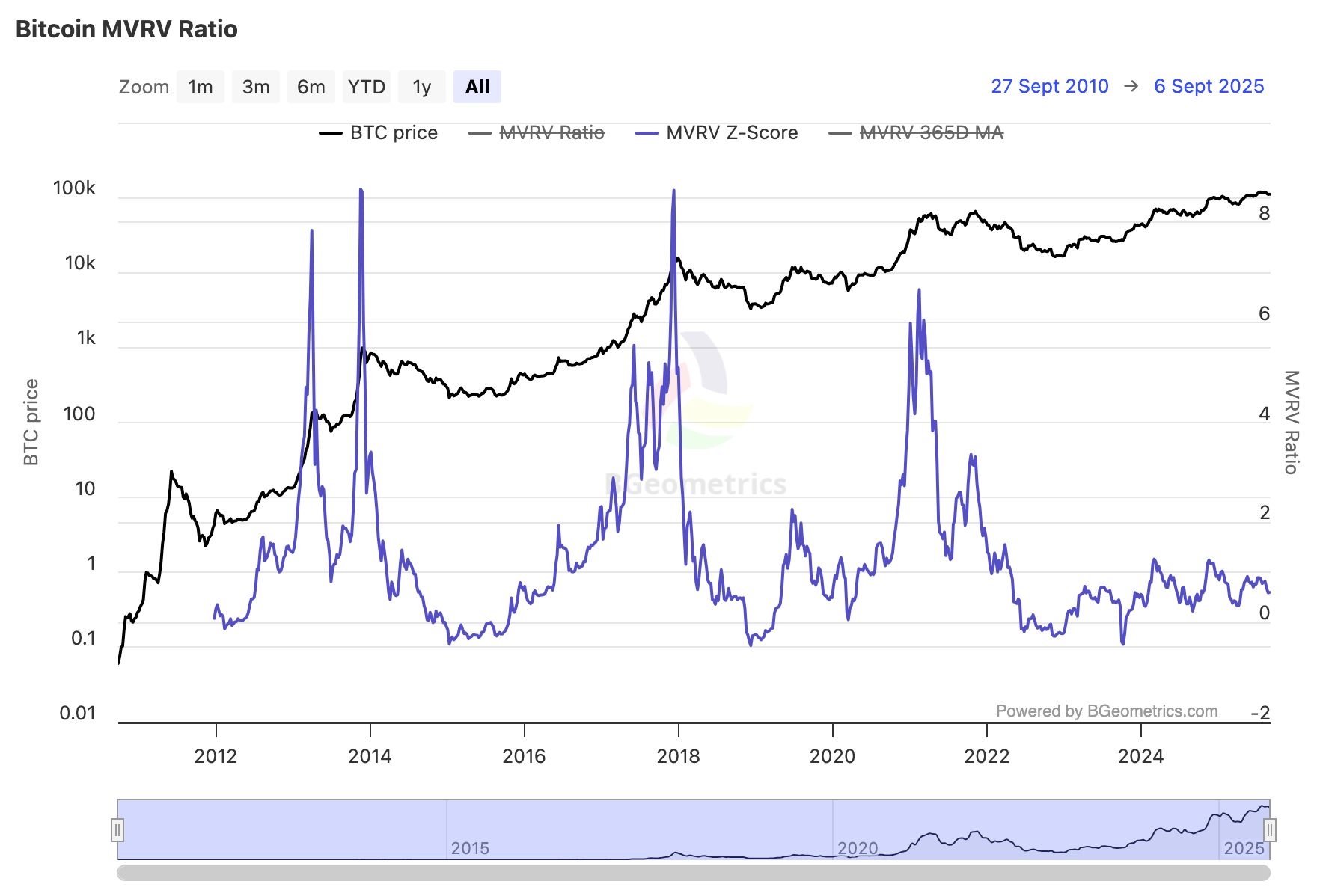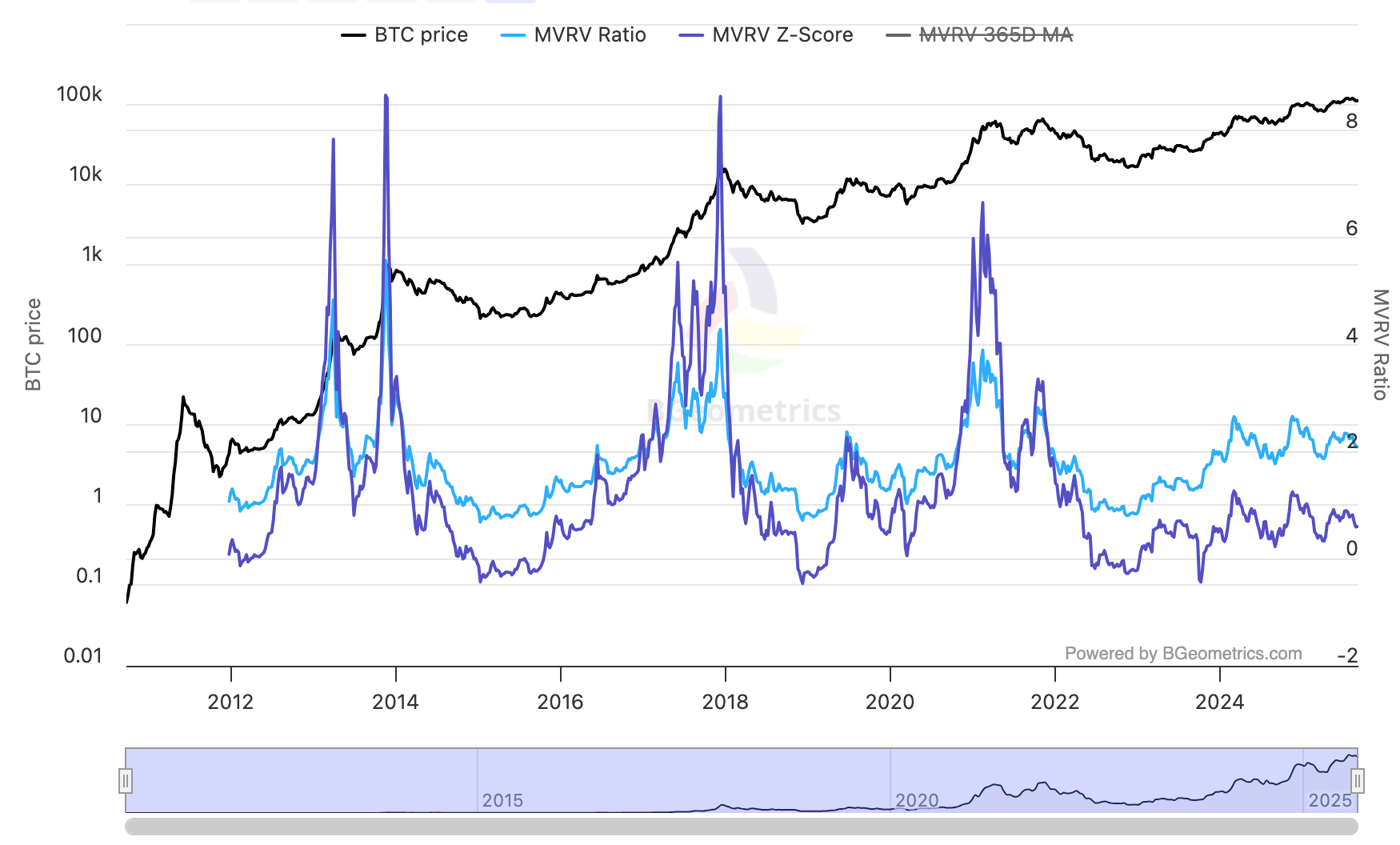What Is the MVRV Z-Score?
MVRV Z-Score is a normalised measure that compares Bitcoin’s market value with its realised value and adjusts for the historical variability of market value. In plain terms, it shows how stretched price is versus on-chain cost basis after accounting for typical volatility.
Z is dimensionless and designed to highlight statistically unusual periods that often align with major cycle extremes.

This chart normalises the gap between market and realised values to highlight statistical extremes and risk bands.
How Is MVRV Z-Score Calculated?
- Market value: current price × circulating supply.
- Realised value: each coin priced at its last on-chain move, then summed.
- Standard deviation of market value: dispersion of market value over a long history.
- Formula: Z = (Market Cap − Realised Cap) ÷ Standard Deviation of Market Cap.
The numerator tracks how far market value sits above or below realised value. The denominator scales that gap by typical historical variability so you can compare across cycles.
Why Use Z-Score Instead of Plain MVRV?
- It reduces regime bias by scaling the premium to historical variability.
- It sharpens the view of unusual extremes that plain MVRV might blur in higher-liquidity eras.
- It improves cross-cycle comparisons and makes banding more informative for risk framing.
Interpreting the Risk Bands
There are no magic numbers, but widely referenced areas help frame risk:
- ≤ 0: depressed conditions where market value is at or below realised value.
- 0–2: constructive zone, typical of early recoveries or steady advances.
- 2–4: expansion with rising risk; watch for confirmation from other indicators.
- 4–6: elevated risk; distribution and mean-reversion become more likely.
- ≥ 7: historically associated with late-cycle risk during strong advances.
Use bands as guides only. Always seek confluence.
Practical Use Cases
Cycle context
Use weekly Z to understand where price sits relative to on-chain value in a statistical sense. Rising Z within mid-bands often aligns with trend continuation; spikes into high bands that fade quickly can signal risk.
Divergences
Higher highs in price while Z makes lower highs can hint at weakening valuation breadth. The reverse can suggest value building beneath price.
Confluence with valuation and spending
Pair Z with plain MVRV, realised price bands (Market, LTH, STH), SOPR, and dormancy/CDD. When Z runs hot while SOPR flips to profit-taking and LTH bands approach, caution rises.
Common Pitfalls
- Treating a single threshold as a hard rule. Bands migrate as liquidity and participants change.
- Reading Z in isolation. Extremes are more actionable when spending behaviour and supply metrics agree.
- Ignoring the pace of change. Fast jolts into high bands that reverse can mark blow-off risk; slow climbs with rising realised cap can persist longer.
A Simple Workflow You Can Reuse
- Open MVRV Z-Score on a weekly chart.
- Note the current band and the direction of travel.
- Cross-check plain MVRV and realised price bands.
- Check SOPR for profit-taking or absorption.
- Scan dormancy/CDD for old-coin spending.
- Decide: is Z signalling manageable premium with support, or an overheated patch with distribution risk?

This comparison highlights how Z refines the read by scaling the premium to historical variability.
FAQ
Is a high Z-Score automatically bearish?
No. Elevated Z can persist when realised cap is rising steadily. Risk increases when Z is in high bands and other indicators confirm distribution.
Which timeframe is best?
Weekly for cycle context. Daily can help timing but is noisier.
How does Z differ from NUPL?
Z compares market and realised values after scaling by market cap variability. NUPL estimates what share of supply sits in profit or loss. They complement each other.
Can I trade solely off Z?
You shouldn’t. Treat Z as a statistical layer within a confluence stack that includes valuation, spending, and supply dynamics.
If this clarified how Z-bands frame risk, join Alpha Insider for Z-Score heatmaps, cycle band guides, and weekly timing windows. Fewer mistakes, cleaner execution, more conviction.
The Markets Unplugged members get:
➡️ Kairos timing windows to plan entries before the crowd moves
➡️ A full DCA Targets page with levels mapped for this cycle
➡️ Exclusive member videos breaking down charts in plain English
➡️ A private Telegram community where conviction is shared daily
➡️ A dedicated Bitcoin On-Chain Analysis page with regularly updated analysis and monthly reports (MVRV, SOPR, NUPL, Puell, URPD)
It’s the full playbook.















Discussion